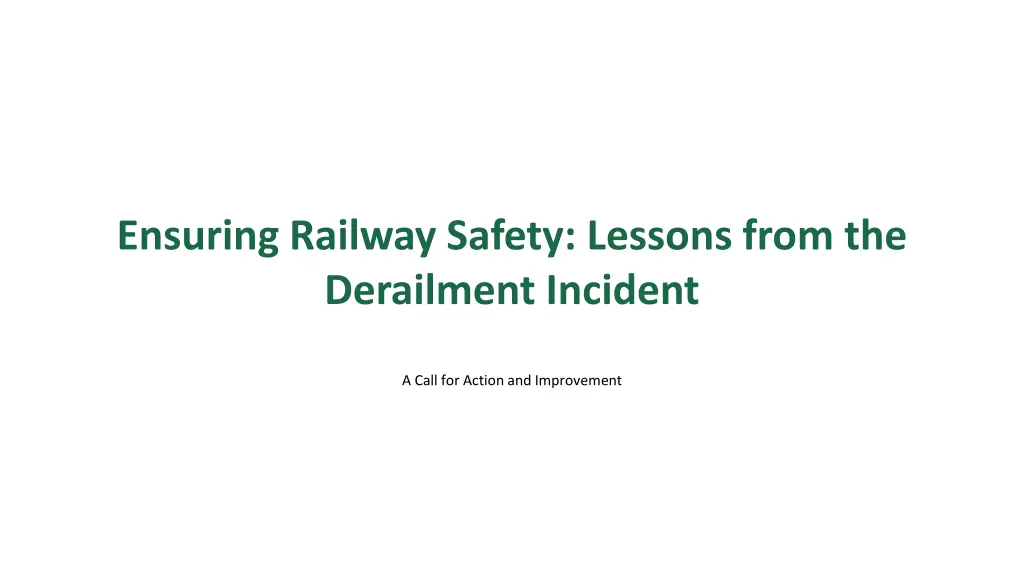
Improving Railway Safety: Lessons Learned from a Derailment Incident
Explore key findings and recommendations for enhancing railway safety following a significant derailment incident. Understand the impact, root causes, and necessary improvements to prevent similar tragedies in the future.
Download Presentation

Please find below an Image/Link to download the presentation.
The content on the website is provided AS IS for your information and personal use only. It may not be sold, licensed, or shared on other websites without obtaining consent from the author. If you encounter any issues during the download, it is possible that the publisher has removed the file from their server.
You are allowed to download the files provided on this website for personal or commercial use, subject to the condition that they are used lawfully. All files are the property of their respective owners.
The content on the website is provided AS IS for your information and personal use only. It may not be sold, licensed, or shared on other websites without obtaining consent from the author.
E N D
Presentation Transcript
Ensuring Railway Safety: Lessons from the Derailment Incident A Call for Action and Improvement
01 An Unfortunate Incident Table of Contents 02 The Nature of the Accident 03 Impact Assessment 04 Root Causes of the Accident 05 Recommendations for Improvement 06 Equipment Maintenance Protocol 07 Technological Advancements 08 Organizational Responsibility 09 Conclusion and Future Path 10 Thank You for Attention
1 An Unfortunate Incident On 13th January 2022, at 16:53 hrs, a derailment occurred on the Northeast FrontierRailway. The incident took place between New Domohani and New Maynaguri stations on the Alipurduar Division's electrified section. The involved train was the 15633 UP Bikaner-Guwahati Express, traveling at a speed of 106 km/h. A comprehensive review is necessary to understandthe factors leading to this tragic event. Let's explore the key findings and recommendations for future safety improvements.
2 The Nature of the Accident The derailment was categorized as a significant accident, impacting lives and railway operations. During this incident, nine lives were lost and many others were grievously injured, highlighting the urgency of addressing safety protocols. It is critical to analyze the nature of the accident for effective preventive measures. Casualty numbers included 22 grievously injuredand 23 with minor injuries. Every life lost is a profoundloss that calls for immediate action.
3 Impact Assessment The estimated cost of damage from the derailment was around Rs 7.15 Crores, underlining the financial implications of such incidents. Beyond financial loss, the emotional and psychological toll on families affected cannot be quantified. Understanding the economics of railway safety is essential for justifying improvements and investments in safety measures. Satisfactory relief arrangements were made for the victims, but more can always be done. A robust relief framework is not just a response but a commitment to the people.
4 Root Causes of the Accident The primary cause of the accident was identified as a failure of railway equipment and poor maintenance practices. The implications of negligence in railway operations must be taken seriously to prevent recurrence. Several key personnel were foundaccountable, establishing a responsibility matrix for future accountability. The role of maintenance staff and operationalmanagers must be re-evaluatedto enhance safety. A culture of accountabilityfosters better safety practices.
5 Recommendations for Improvement To prevent such accidents in the future, the railway should establish a national database for locomotive management. This database should capture historical data on inspections, failures, and maintenance schedules. Accessibility to this data for operational staff can ensure timely interventions when necessary. Automated alerts for overdue inspections can enhance safety and operational integrity. Maintaininga proactive approachcan avert potential disasters.
6 Equipment Maintenance Protocol Locomotives that have served for 18 years or more must be replaced on a programmed basis, ensuring reliability. Identifying and withdrawing faulty traction motors can prevent futurefailures and enhance safety. Immediate action is needed for components of poor quality identified throughrigorous checks. Investing in better quality control and maintenance practices is vital. Quality is non-negotiable when it comes to safety.
7 Technological Advancements Implementing electronic detection systems for traction motor failures can significantly reduce risks. An electronic alarm system for critical failures creates immediate awareness for timely intervention. Technology can bridge the gap between potential failure and operational safety. Utilizing modern technology can lead to more reliable operations and better safety outcomes. Innovative approaches are essential in risk management.
8 Organizational Responsibility The incident also unveiled the necessity for a clearer structure of responsibilities within the railway system. Key personnel from various divisions were identifiedas accountable, highlightingthe need for definedroles. Establishing a systematic responsibility chain can promote better adherence to safety protocols. Communication and training must be prioritized at all levels to ensure a safety-firstculture. A well-informed workforce is pivotal for operational success.
9 Conclusion and Future Path As we reflect on this unfortunate incident, our focus must shift to proactive measures. Safety is a collective responsibility; every stakeholder plays a role in safeguardinglives. Implementing the recommendations effectively can transform the railway landscape. Continuous improvement and accountability can preventfuture tragedies. Together, let's strive for a safer railway future.
10 Thank You for Attention Thank you for your attention and commitment to railway safety. Your role in implementingchange is crucial for enhancing safety standards. Together, we can learn from the past and build a safer future for all travelers. Let's ensure that tragedies like this are not repeated. Your engagement is key in this vital endeavor.
